Why tap water and how to clean it
The fact that water from the tap in our time can not be drunk - everyone knows, however, not everyone knows why it is harmful, and how to clean it. Below we take a closer look at what is often the composition of tap water, and how to improve its quality at home and make it suitable for drinking.

Composition of water
First, consider whether the tap water is harmful or its negative impact on the body is greatly exaggerated? As a rule, after processing at the enterprises of Gorvodokanal, it meets the requirements of SanPiN, i.e. is harmless to the human body. However, in the distribution network it is subject to secondary pollution.
So, the most common pollutants are:
- Manganese;
- Iron;
- Fluorides;
- Sulphides;
- Magnesium salts;
- Calcium salts, as well as all sorts of organic compounds.
Below we take a closer look at how these pollutants affect human health.
Tip! Many people are interested in - how many calories in tap water? In fact, water does not contain calories, as it contains no proteins, carbohydrates and fats.
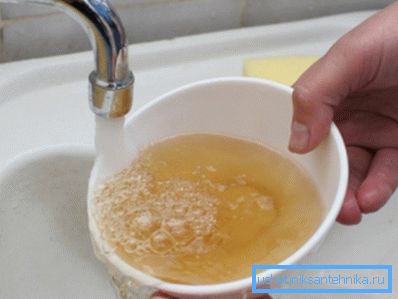
Iron
Iron, which is contained in the water, does not threaten the health, however, if its content exceeds the norm, the water becomes an unpleasant reddish-brown hue, besides its taste deteriorates.
From a one-time use of such water will not be anything. If you use it for a long time, you can develop various diseases of the liver, blood, disorders of the reproductive system, allergic reactions, etc.
Tip! To keep the sound of water from the tap quieter, install an aerator on the spout. In this case, it will flow in an orderly stream.
Manganese
Manganese is a rather dangerous pollutant, as it can lead to such diseases as:
- Anemia;
- Violation of the functional state of the CNS.
In addition, the use of such water during pregnancy causes the risk of stillbirth and pathogenic birth.
Note! If the water smells unpleasant, the cause of this phenomenon is the presence of hydrogen sulfide in it.
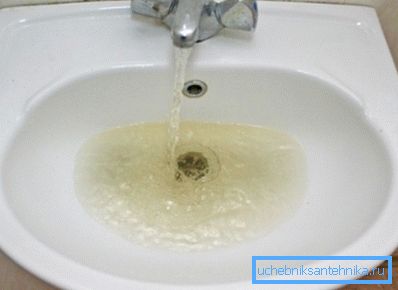
The salt
If the water exceeds the salt content (chlorides and sulfites), then the taste becomes unpleasantly salty. When you use such a liquid, there are violations in the gastrointestinal tract. Harmful to health is water containing per liter:
| Chlorides | More than 350 mg |
| Sulphates | More than 500 mg |
Note! Many people are faced with such an unpleasant phenomenon, when the water hits the current. If this situation is constantly observed, it is necessary to report the problem to the electrician, as this can be life threatening. In some cases, the cause of an electric shock is static voltage, which is safe for health.
Calcium and Magnesium
If the water contains cations of magnesium and calcium, then it becomes more rigid. The normal level of hardness is 3.0–3.5 mg eq / l. Regular consumption of such fluid from the pipes leads to the accumulation of salts in the body and, ultimately, disease of the joints, such as polyarthritis, arthritis, and the formation of stones in the urinary and gall bladders, as well as in the kidneys.
Fluorine
The use of water from the tap with a high content of fluorine leads to the following diseases:
- Washout of calcium and phosphorus from the body, including from the bones.
- Suppression of immune reactivity.
- Morphofunctional changes in the organs (kidney and liver).
Note! Low fluoride content is also negative for the human body. In order for water not to be harmful, its content should be in the range of 0.7 - 1.5 mg / l.
All of the above pollution are chemical. However, organic pollution may also be present in the water - these are all kinds of bacteria that cause diseases.
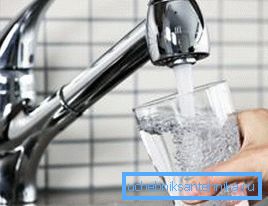
Water purification
Despite the fact that tap water contains many different harmful impurities, it can also be made drinking at home. Below we will look at several options for how to clean tap water.
Immediately it should be said that before you perform the cleaning, you need to know exactly what exactly the water is polluted. To do this, it must be attributed to the analysis of the SES or a private laboratory. I must say that the price of the services of the latter may be higher, however, such laboratories, as a rule, provide a more accurate result.
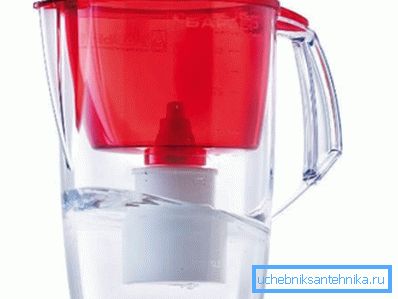
Softening
The most common type of water pollution is the presence of large amounts of iron and minerals. Therefore, first of all, we consider how to soften the water from the tap.
So, you can do this in several ways:
- Boiling - is the easiest way to get rid of excess impurities. After boiling a film will appear on the surface of the water, which must be carefully removed. Also, it will help in this situation, the sedimentation of water, as a result of which the impurities themselves will depart, however, it will take more time.

- Using a jug filter - this device is relatively inexpensive and is sold in many stores. The only thing to be kept in mind is that periodically it is necessary to replace the cartridges of such devices; if this is not done, the quality of the water deteriorates.
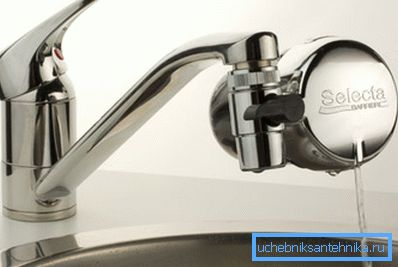
- Filter tip on the crane - provide the same cleaning as jugs, but they are more convenient to use. Some models allow you to turn on and off do-it-yourself cleaning when you need it.
Note! When using a filter tip for spout, the temperature of the tap water should not exceed 35 degrees Celsius, otherwise the filter may deteriorate.
Complex cleaning
If the water has more serious pollution, then the cleaning problem can be solved only by installing a comprehensive filtration system. These devices are connected to the water supply and, as a rule, are installed under the sink. The installation instructions for the filters are quite simple, so installation is not difficult to perform on your own.
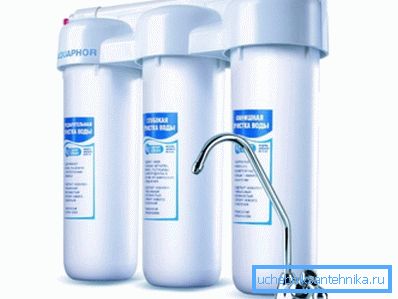
Water purification in these devices is carried out in stages:
- The first is a rough cleaning - the liquid is cleaned from large components - particles of rust, sand, etc.
- This is followed by a fine cleaning, which detains the smallest impurities that are invisible to the naked eye. As a rule, fine cleaning is carried out with a rope filter.
- Then the liquid is absorbed, i.e. destroy all bacteria that can harm the human body.
- After that, the liquid softens as a result of the elimination of iron and lime.
Tip! On sale there are mixers that have two outflows, thanks to which you can perform the separation of the liquid into purified and technical.
I must say that the cost of such installations is the highest, however, after cleaning the tap water in such a system, you should not worry about its quality, since it is not inferior to bottled water.
As a rule, systems operate on the principle of reverse osmosis, i.e. final cleaning is carried out by passing water through the membrane, which retains all elements exceeding the size of water molecules.
Here, perhaps, all the basic methods of cleaning tap water at home.
Conclusion
As we found out, the use of tap water can lead to various serious diseases. The solution to this problem is to use filters, however, before installing them, it is necessary to perform an analysis in order to determine which type of filter is needed in a particular case.
The video in this article will provide an opportunity to find additional information on the above topic.